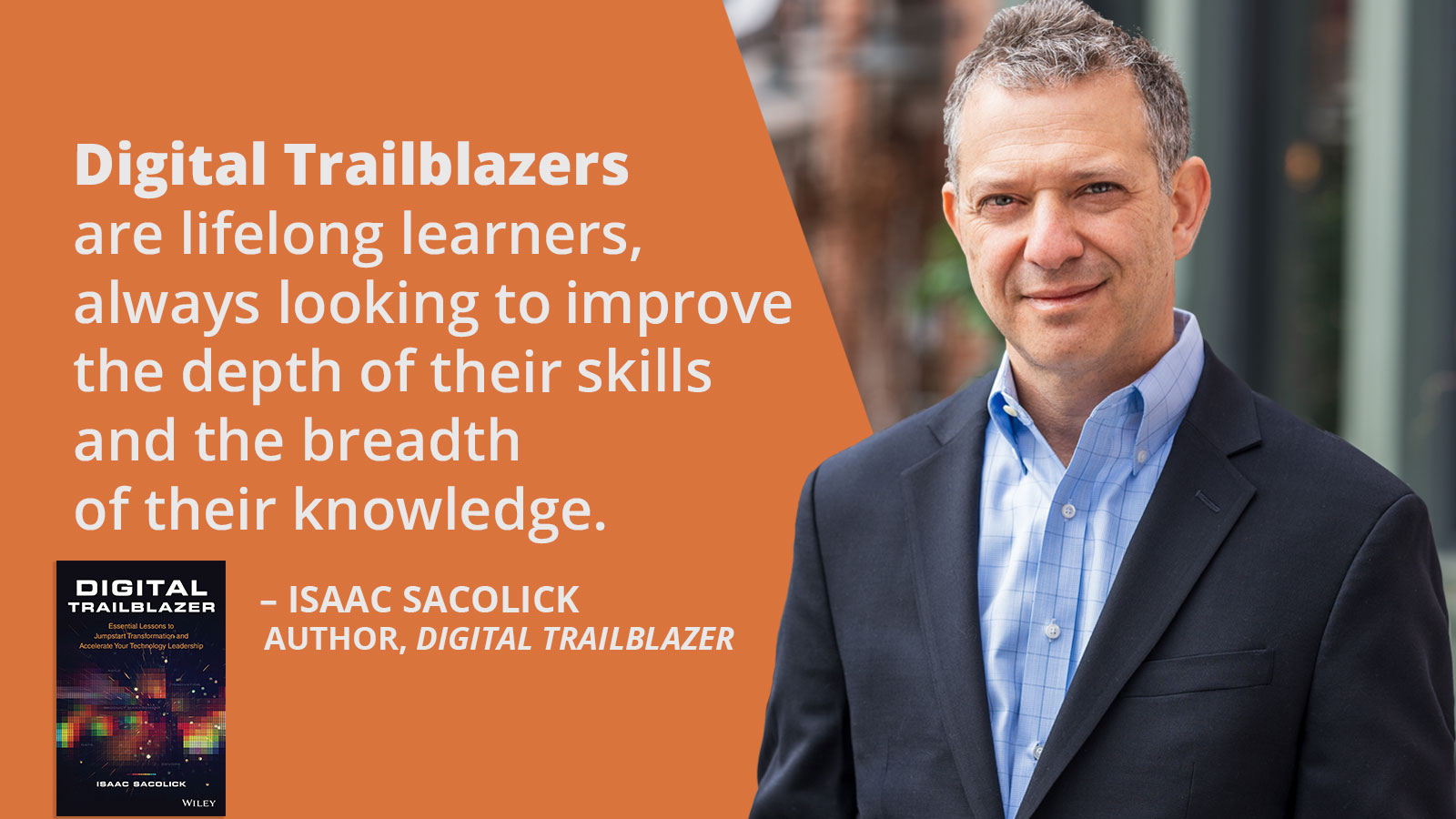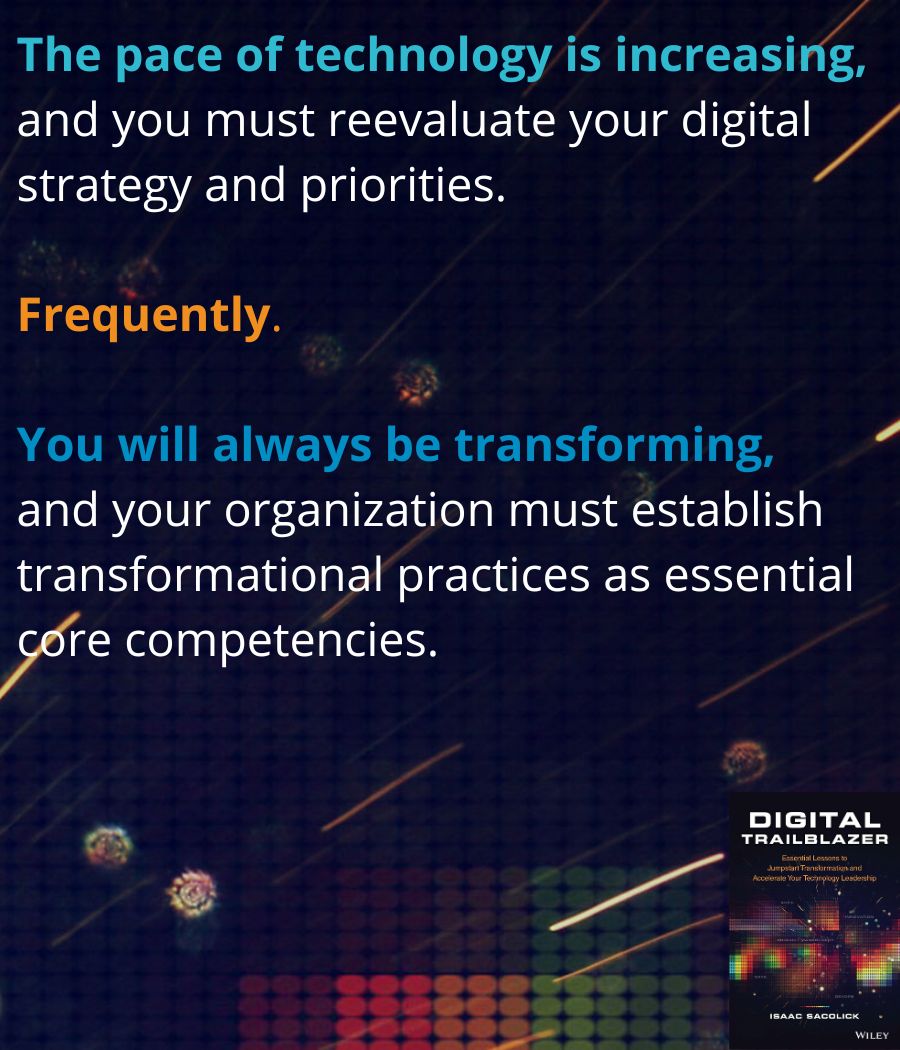As I board the plane from San Francisco to Newark, I make a stark realization. Wow, it’s been a year since I received my author’s copies of Digital Trailblazer and eighteen months since I submitted the manuscript to Wiley.
Writing, publishing, and marketing a book isn’t a journey – it’s a
rollercoaster with days of ups and downs.
I love hearing from readers how the book inspired them and provided important insights into leading digital transformation initiatives. I applaud when reviews come in, or people share their insights on social media. And I am thrilled to answer questions at events from IT, digital, and data leaders about finding force multipliers in their digital strategies.
But marketing a book is super challenging, and I must fight off the same
questioning and doubting all leaders feel about their personal goals and
leadership objectives. A delayed flight, a client has a critical P1 issue,
and I have three articles to finish over the weekend. Being a guide to
Digital Trailblazers isn’t all rosy, but I am prepared. In the book, I share
my stories of confronting stress and leading through challenging
moments.
I recommend finding the right times to reflect on your rollercoasters, and
now’s the perfect time for me on this long flight.
Here are five of my key learnings since publishing Digital Trailblazer.
These are in no particular order, and I believe they are all critically
important.
Work-life balance is not enough – aim for work-life-learn

I define Digital Trailblazers as
lifelong learners
because of the pace of technological change and how quickly leaders must
pivot to shifting customer needs and evolving market conditions. People
agree in principle, but in reality, it’s really hard to dedicate sufficient
time and energy to practice continuous learning.
We strive for work-life balance – and that’s really important, but sadly
insufficient.
If we leave learning as a bullet under work, we’re at our employers’ mercy
to be enthusiastic supporters. I don’t believe that’s the case, from the
CIOs and CDOs I speak to who say they’re overwhelmed and don’t have time to
go to a conference, join a roundtable, or keep up with all the reading
they’d like to do.
And if we put it under life, so many other aspects of living, including our
health and time with loved ones, take higher priority.
We need a constant reminder of how important learning is to our teams, families, and ourselves – especially when some governments are banning books. My simple answer is to expand our thinking from work-life to a work-life-learn balance because learning is one of everyone’s key long-term investments.
Generative AI illustrates why organizations will always be transforming
Here’s one of my key statements in Digital Trailblazer –
“The pace of technology change is increasing, and you must reevaluate your digital strategy and priorities. Frequently. You will always be transforming, and your organization must establish transformational practices as essential core competencies.”

When I wrote that statement, I was thinking about how we had to pivot from
hypergrowth in 2018-2019, to pandemic survival in 2020-21, to the new
normal, inflation, recession, and war in 2022-23.
Transformational change won’t stop there.
Generative AI was an experiment many thought was years or decades away. But
since ChatGPT’s record-paced growth to one million users and beyond, it’s
forced all business leaders to consider opportunities, risks, and disruption
from generative AI.
Many are already experimenting with generative AI, large language models,
and ChatGPT, and I expect AI will move up in many companies’ digital
transformation priorities. We’ll always be transforming.
Promoting diversity and inclusive debate is a primary leadership responsibility
Consider the questions you plan to ask when hiring your next leader. What
leadership qualities do you seek when interviewing a CXO, VPs, Directors,
and team leads?
I suggest asking candidates what leadership responsibilities they think are
critical, and if DEI isn’t one of them, confront them and ask them why.

Chapter 8 of Digital Trailblazer on building diverse leadership teams was
the hardest to write. I rewrote it several times and discussed the
experience in
my interview about this chapter. Just last week, I had the opportunity to listen to the chapter again, and
I believe it’s essential reading, listening, and learning for everyone. If
you feel otherwise, please let me know.
While there’s a more diverse talent pool in IT and many more women and
minority technology leaders, we’re still nowhere near what’s required. When
I attend an IT conference with 100 leaders and only ten women, I know it’s
far better than the same conference just four years ago. But we aren’t close
to objectives.
One problem is that we make small mistakes that can be impactful. I feel a
stabbing in my gut every time I mistakenly say “he” instead of being more
gender-neutral. I recently witnessed a male leader cut off a female
technology leader on a virtual roundtable, and sadly, none of us called out
this behavior. We should avoid cutting people off regardless of gender and
background, and we must do a better job of thinking before speaking and
acting. But I think to myself afterward, will she think twice before
contributing again?
We’re not always in a position to hire, but I believe promoting inclusive debate is one way to encourage diverse thinking on a daily basis.
Make no mistake; hybrid working is a big part of the future of work

Every week there’s another article about why and how company executives are
trying to get butts back in seats back at their offices. It reminds me of
the days when CEOs and CFOs gave up on agile methodologies six months into
their maturity and asked their PMOs to revert to waterfall command and
control practices.
Companies went 100% remote overnight, and hybrid working is only in its
second year. Do you think we’ve figured out all the best practices, tools,
and leadership qualities to excel at this model? Executives must show much
more patience and openness to experiment to make
hybrid working a competitive advantage.
Why? Because people want a work-life-learning balance, not long commutes,
limited family care options, and work where they’re bouncing from one
conference room to another and having bosses micromanaging their work
ethics.
Hybrid working is a two-way street; employees must demonstrate their
productivity, abilities to collaborate as a team, and effectiveness in
delivering innovations. That will require Digital Trailblazers to act
strategically on when, where, why, and how to bring people together. I
expect we’ll see more creative offsite gatherings, group workshops, and
team-building programs by the most forward-looking leaders.
Eventually, we may see smart building and smart city initiatives that will help swing the pendulum back toward working in “offices,” but if I were working today, I would dread taking steps four years backward.
Business execs “get” the need to transform, but mindset-changing is slow
I recently submitted an article for CIO.com (not published yet) on mistakes
when presenting to the Board of Directors and included some surprising
stats.
In 2019, MIT reported that only 24% of US boards of companies with over $1 billion in revenue were digitally savvy. A more recent review reports that only 51% of Fortune 100 companies and 9% of Fortune 200 through 500 organizations have a director with relevant cybersecurity experience.
Now contrast these actions with
Gartner’s findings
that 89% of Boards state that digital is embedded in all business growth
strategies, but only 35% believe they’re on track to achieving digital
transformation goals.
Gartner’s CIO Agenda 2023
reports that 59% of digital initiatives take too long to complete and 52%
too long to realize business value.

Digital Trailblazers know how important it is to build executive relationships and get top-down buy-in on digital transformation strategies. The data illustrates how hard it is to get an executive from support to action.
Here’s what I wrote in Chapter 10. “Support is an interesting word. Just
getting an executive’s support in a conference room only amounts to their
decision not to confront you. However, if you want that executive to follow
through and to go beyond support and endorse followed by action, well then,
that’s a whole other mountain you’re climbing.”
The point is that digital transformation is hard – even with the threat of
business disruption and the opportunity to develop new digital capabilities
that delight customers. I applaud all of you for working hard at it.

Thank you for joining me on the rollercoaster, and I have plenty more to
share with you, including the last part of the interview series, which you
can watch in the
Chapter 10 video
below. I lead a
community for Digital Trailblazers
and hope you’ll join us.
Onward to tomorrow’s opportunities.

No comments:
Post a Comment
Comments on this blog are moderated and we do not accept comments that have links to other websites.